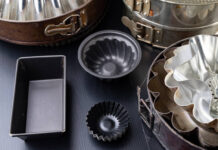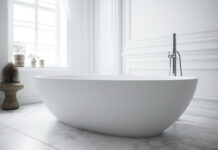Purchasing a toolbox is a housewarming rite of passage, but for DIY newbies the hardware store can be a confusing and intimidating place. It’s not easy to know which are the best tools for DIY and which will sit around in your cupboard until you move out again.
How do you choose between the 40-odd varieties of hammer? And should you believe the poster declaring that your broom cupboard is not complete without an industrial-strength circular beam saw?
We spoke to two DIY experts – Shuf Shah, senior buyer for DIY at Robert Dyas, and Demi Stanley, professional handyman with Fantastic Services – to sort the household essentials from the workshop luxuries.
10 best tools for DIY
With these 10 tools in your arsenal, you’ll be more prepared than a boy scout with over-protective parents.
1. Screwdrivers

A pleasingly self-evident choice (because, try not to gasp, it drives in screws), the screwdriver shouldn’t need too much explanation.
Shah ranks it as his most used implement: “For me, it’s essential to have a set – so you can find the right fit for different screws. A Stanley 34-piece set will have a range of options, like ratchet screwdrivers or micro-screwdrivers – really useful if you’ve got a hinge issue in your glasses.”
Flat-pack wardrobes, DIY shelving, even just unscrewing the back of your radio – the uses of the screwdriver are manifold. “Our best-selling screwdriver right now is a Draper cordless set that goes at different angles,” adds Shah, “you can click it into a pistol shape which allows you to access those hard-to-reach places which might not fit a normal model.”
2. Tape measure

An equally unsurprising entry is the tape measure. You’ll able to take and compare precise measurements forms the foundation of even the least technical DIY task.
“It’s an irreplaceable instrument for every renovation, carpentry or decorating project,” says Stanley, “for measuring space when choosing new furniture, measuring the walls to work out how much paint you need, marking anchor points and so on.”
3. Hammer

Undoubtedly one of the best tools for DIY and arch-nemesis of sore thumbs everywhere, your hammer is the all-purpose enforcer of your toolbox. “Most people will need a hammer,” says Shah, “they’re perfect for knocking in pins or nails, and there’s no other tool that can really do that job.”
Not all hammers are entirely blunt instruments: “I would always get a claw hammer,” says Shah, “because as a DIY-er, you’re not always going to get it right first time. The claw can remove things from walls with minimal damage and lets you start again.”
4. Spirit level

Even the most amateur DIY requires a certain amount of precision, and this mysteriously named gizmo allows you to perfectly align your home with gravity.
“A level assures you set up level points either when hanging pictures or putting up shelves,” says Stanley. “It is extremely useful for drawing straight lines on walls and woodwork where you intend to hammer or drill. When you’re installing appliances, interior doors, laminate flooring or tiling, the flat surface is a must.”
5. Drill

The ultimate in handyman aesthetic – if you’re posting about your #DIYlife on social media, this is definitely the tool to pose with. Selfies aside, the power drill is the big beast of the DIY world. Aside from its day job of boring holes in walls, the right drill bit allows you to drive in screws more quickly and powerfully than any screwdriver.
“You can buy a corded or cordless drill,” says Stanley, “but either way, the purpose is the same: To better install or remove screws, and drill holes in walls, for shelf-building projects, installation of bathroom accessories, fitting blinds and curtain rods…” The list goes on.
6. Utility knife

“A utility knife is incredibly useful for all your common cutting jobs,” says Stanley, “like cardboard, drywall, plaster, package opening, tape, cords, cables, wallpaper and so on. It’s an everyday DIY assistant.”
This is one of the best tools for DIY as you’ll find uses for it everywhere. As ever with sharp implements, safety comes first. Pick a design with sturdy casing and a well-sheathed blade, and seek advice if you’re not sure.
7. Adjustable wrench

We’re not sure why it’s called a ‘wrench’ when it’s clearly just an adjustable spanner, but this industrial-looking implement is a great, multi-purpose addition to your toolbox.
“This toolbox essential means you don’t need a whole set of spanners,” says Shah. “It’s one those tools you won’t use all the time, but you just know you’ll need at some point. There’s loads of little uses – like tightening the legs of a fridge or washing machine.”
8. Pliers

Your first port of call for snipping, gripping, tweaking, retrieving, and pretty much everything else, household pliers are an all-purpose utility tool you’ll constantly be finding uses for.
“Every DIY-er should possess two types of pliers,” says Stanley, “needle-nose pliers and groove-joint pliers. The former are most commonly used in plumbing, when you need to fix a pipe, or tighten and loosen threaded pipes, nuts and fittings. The latter will help you grip objects with an irregular shape.”
9. Sander

OK, maybe essential is stretching it, but a sander can make your life a great deal easier in houses heavy on wood.
“Repainting something that’s been varnished, smoothing wooden furniture, skirting boards or handrails – electric sanders ensure a smooth and consistent finish with minimal effort,” says Shah.
Most of all, they’re a time saving device: “Sandpapering by hand takes forever and makes a lot of mess. We’ve got one at the moment which has a collecting box at the back – so it hoovers up the sawdust as you go.”
10. The box itself

We know this isn’t a tool as such, but not all toolboxes are created equal, and it’s worth putting some thought into getting the right one.
“The toolbox itself is easy to gloss over,” says Shah, “but you want to find one that has segments in it and is the right size. You’ll want a smaller section for your screws, nuts, bolts and bits, and a bigger section which should nicely fit your bigger tools.”
Now you should know which are the best tools for DIY for you.
You may also be interested in…































































